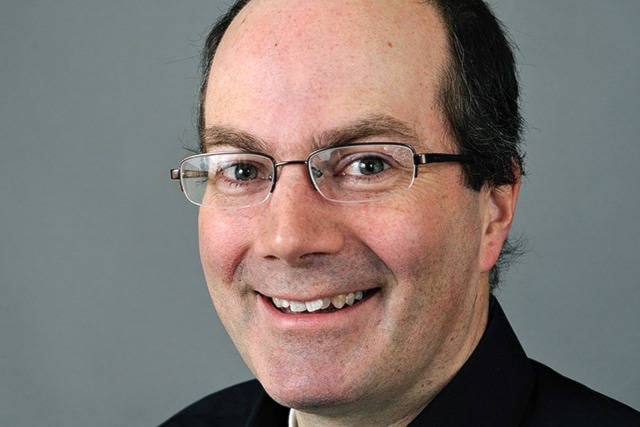As so often, Wyatt captured the whole complex issue perfectly in one cartoon on the Yukon News editorial page.
Its three panels each show the same fellow reading the newspaper, first as a boy in the 1990s, then a young man in 2009 and finally in middle-age in 2019.
The punchline is that the headline is the same in each year: “Educational outcomes differ between Indigenous and non-Indigenous students.”
In a telling flourish, Wyatt shows the passage of time by having the logo on the guy’s hat change from the Habs to the Oilers to 2019’s NBA champs.
A lot changes in the world, but not the auditor general’s opinion about the performance of the Yukon Department of Education.
The 2019 findings were grim reading. Only 49 per cent of First Nations students entering Grade 8 graduated within six years, compared to 81 per cent for non-First Nations students.
That’s terrible news.
Even worse was what the department has been doing — or not doing — about it. The report has some devastatingly direct feedback.
“The Department made little effort to understand the root causes of gaps in student outcomes and had no strategy to close those gaps.”
“The Department did not do enough to create a partnership with Yukon First Nations.”
“Only five per cent of the (Individual Education) plans we looked at showed that the services and supports recommended by specialists or school staff were delivered.”
It’s hard to find a word to describe this situation.
“Surprising” doesn’t work. If you talk off-the-record with senior Yukon officials or politicians from any political party, you’ll find the performance of the Department of Education is one of the few things they all know about and agree on.
This isn’t the Department’s first audit, and ministers from multiple governments have found themselves dealing with the department’s fallout over the years.
“Unacceptable” doesn’t work either. As Wyatt’s cartoon acidly points out, we seem to have been accepting this for decades.
“Life-changing” is apt, and not in a good way. It’s impossible to describe the effect of a poor education on a young person’s life story in one sentence, so I’ll just share one fact from last week’s Economist magazine. “Each high-school graduate who does not go on to earn a certificate from a vocational or technical school, or a two- or four-year degree from a community college or university, misses out on US$1 million in lifetime earnings.”
That’s American data but the effect would be similar elsewhere in North America, including the Yukon. And that statistic is only about young people not completing post-secondary trades or university training. It doesn’t even cover the bigger social and economic cost of the kind of low high-school graduation rates highlighted here by the auditor general.
There are plenty of troubling statistics linking dropping out of high school with higher rates of incarceration and other social ills later in life.
The auditor general focused on the disturbing and sustained gap between First Nations and non-First Nations students. But that doesn’t mean the report gave the department an A+ on the education it provides non-First Nations students.
One chart stands out. The percentage of First Nations students who met or exceeded expectations in numeracy in Grade 7 was 44 per cent. The number was less bad for non-First Nations students at 77 per cent.
Think about both those numbers for a minute. We are on the cusp of a massive digital revolution in our society and economy. There won’t be techies in the future, since nearly everyone will be using digital tools at work. And yet between a quarter and a half of our young people don’t have the numbers skills expected when they enter high school.
So what are we missing?
It’s not a shortage of money. A Statistics Canada study from 2015 showed the Yukon spent more than double per student what most provinces do.
It’s not a shortage of education officials at head office. The Department’s most recent budget has $3 million for “Administration,” $11 million for “Corporate Services” and $26 million for “Policy and Partnerships.”
Nor is it a shortage of strategic planning exercises. Flipping through the department’s annual reports over the period covered by Wyatt’s cartoon, we have seen a number of well-funded consultation and planning exercises that came up with new strategies. For example, in 2005 we had the Education Reform initiative. In 2011/12, we had the “Accountability Framework.”
This included the “Pyramid of Intervention” and the “Yukon Assessment Matrix.” In 2015, the Department said “We have established a process and steering committee in order for us to work with our partners to collectively build and implement a new vision for education in Yukon.”
And so on.
The department has accepted the auditor general’s findings and promised to work on them. We can expect a new public consultation and strategic planning exercise.
The department’s past record does not inspire confidence that the outcome will result in a different Wyatt cartoon in 2029.
So what does all this mean for Yukon students, parents and First Nations leaders who care about education? We should all hope the Department of Education responds more effectively to this audit than the last one. In the meantime, if you haven’t already, you would be wise to work on your own education initiatives at home or with your local school.
Keith Halliday is a Yukon economist and author of the MacBride Museum’s Aurore of the Yukon series of historical children’s adventure novels. He is a Ma Murray award-winner for best columnist and received the bronze for Outstanding Columnist in the 2019 Canadian Community Newspaper Awards.
